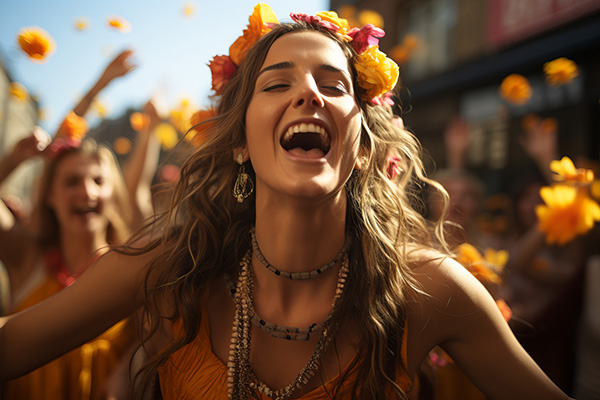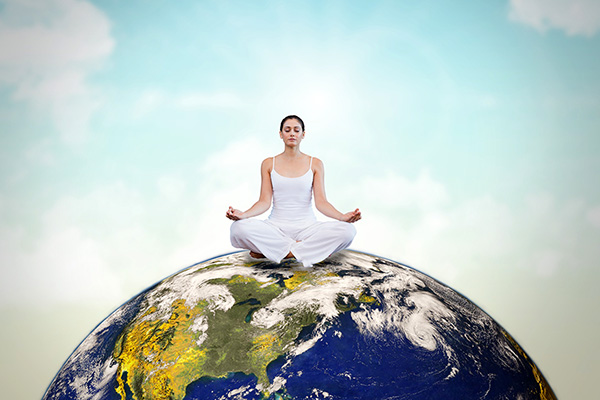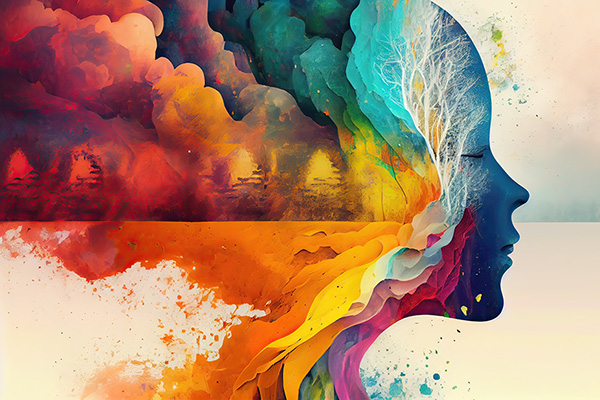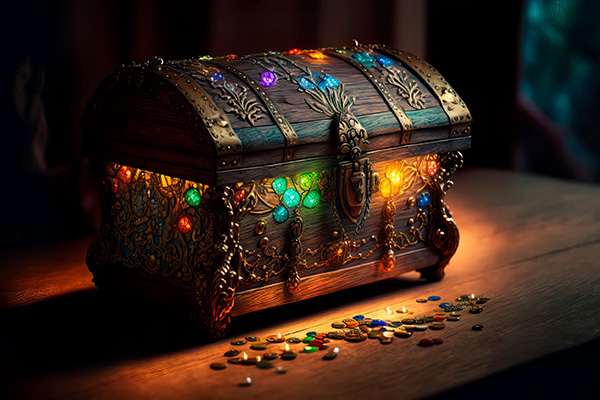music
The Soulful Practice Of Kirtan Chanting
 An ancient spiritual practice less known in the West has transformed my spiritual routine in recent years. It is known as kirtan a beautiful form of devotional chanting that originated in ancient India.
An ancient spiritual practice less known in the West has transformed my spiritual routine in recent years. It is known as kirtan a beautiful form of devotional chanting that originated in ancient India.
The term “kirtan” comes from Sanskrit and means “narrating, reciting, telling, describing” of an idea or story, particularly in a religious context. This enchanting practice weaves together music, meditation, chanting, and a deep sense of spiritual expression.
Kirtan is a central practice in the Bhakti Yoga tradition, which emphasizes love and devotion to a personal deity. It involves the repetitive chanting of mantras and divine names, traditionally in Sanskrit, accompanied by musical instruments such as the harmonium, tabla, and cymbals.
Traditionally, kirtans focus on chanting the names of deities like Krishna, Rama, or Sita. The kirtan leader sings a line and the congregation responds, creating a rhythmic and melodic interplay that is both meditative and invigorating.
While Kirtan remains rooted in its spiritual origins, it has gained global popularity beyond India and the Bhakti tradition. As the practice of yoga has boomed worldwide, kirtan too has seen an immense rise in popularity. It’s a testament to the universal appeal and transformative power of this captivating practice.
Kirtan events and gatherings are known for being welcoming and inclusive, focusing on the shared experience of chanting rather than strict religious adherence. Unlike the typical musical experience in spiritual settings, kirtan invites everyone to participate in a soulful, call-and-response chanting that creates a profound connection to the divine and brings people closer together.
Raise Your Vibration With Humor, Fun And Laughter!
 I recently completed the first of two months of practice in a year-long advanced psychic development course that I am currently taking. The practical tests were quite challenging, even for an experienced psychic, but overall I am happy to say that it went quite well.
I recently completed the first of two months of practice in a year-long advanced psychic development course that I am currently taking. The practical tests were quite challenging, even for an experienced psychic, but overall I am happy to say that it went quite well.
One of the tests required us to do a psychic reading for a stranger via video call, with the goal of perceiving details about the person at different stages of their life. In other words, we had to sense significant details about them when they were children, teenagers, in their 20s, 30s, 40s, and so on.
Before my test reading, I prepared by mentally focusing on the lady I was to read for and I did this while walking my dogs. I have found over the years that this daily time outdoors with my beloved pets is great time to receive psychic information.
It also helped that we were sent a photo of our randomly assigned subjects in advance, so I could also visualize her in my mind’s eye, which makes the process easier.
So, by the time I called her on FaceTime for the reading, I had already written down a lot of information about her younger years before the session began. For example, I had seen that she had a fairly happy childhood and even had a vision of her blowing on daisies to make a wish.
Energy Imprint, Energy Cord, Or Entity Attachment?
 In my work, I often encounter people who are experiencing phenomena that are negatively affecting their energy field, causing them to suffer a loss of physical, mental, emotional, and spiritual health and well-being.
In my work, I often encounter people who are experiencing phenomena that are negatively affecting their energy field, causing them to suffer a loss of physical, mental, emotional, and spiritual health and well-being.
Usually these problems are simply due to their own negative thinking, or external negative energy imprints or residues that their aura has picked up from toxic people or environments. In many cases, it can be due to the energy cord of a dysfunctional or unhealthy romantic relationship or other types of energy cords with family, friends, or co-workers that are contaminating or draining their personal energy and vitality.
In some cases, however, these negative energy influences have a far more sinister origin that the “carrier” or victim is rarely aware of, while it is destroying their well-being and wreaking havoc in their lives.
The problem is that many people do not understand the difference between negative energy imprints, energy cords, and evil entity or spirit attachments. In my experience, the confusion is mainly due to the fact that the effects these three categories of negative energy phenomena have on people are often similar, leading to misinterpretation of the source or cause of these influences and disturbances.
Let Go And Embrace The Cosmic Dance!
 Life is a mystical dance where the things we know and the mysteries we’ve yet to discover dance an intricate tango. And the universe invites us to let go and groove to the enchanting rhythm of this dance.
Life is a mystical dance where the things we know and the mysteries we’ve yet to discover dance an intricate tango. And the universe invites us to let go and groove to the enchanting rhythm of this dance.
But here’s the thing – we often get tangled up in our own threads of attachment and resistance that interfere with our divine energy flow. In order to dance our best dance, we must learn to let go of what does not serve our flow. Letting go, releasing, surrendering is like untangling a messy knot that allows our mind, body and soul to boogie more freely!
In this dance of life, a psychic, medium or energy healer is like a cosmic DJ who can help you drop the limitations of the ego to participate more fully in the cosmic symphony. We help people transform their baggage of attachment into the gold of spiritual joy and fulfillment.
Whether it’s material possessions, toxic thoughts and feelings, dysfunctional relationships, or limiting fears and beliefs, attachments are like veils covering the radiant essence of your soul. You are potentially a spiritual alchemist who can dissolve these veils with the elixir of surrender. When we release our ego grip, we reveal the hidden sparkle of our soul in the divine light.
Envisioning A Better World For All
 More than a century ago, the great Indian sage Paramahansa Yogananda spoke in his teachings and writings about envisioning a better world for all. He believed in the transformative power of individual and collective consciousness and emphasized the importance of spiritual practices such as meditation and self-realization in creating a more harmonious and compassionate world.
More than a century ago, the great Indian sage Paramahansa Yogananda spoke in his teachings and writings about envisioning a better world for all. He believed in the transformative power of individual and collective consciousness and emphasized the importance of spiritual practices such as meditation and self-realization in creating a more harmonious and compassionate world.
Yogananda stressed that true change begins within each individual. He believed that by working on our own spiritual growth and self-realization, we radiate positive energy and higher consciousness that contributes to a more peaceful and loving world.
He encouraged individuals to envision a new world of peace, harmony, and unity. By holding this vision in our minds and hearts, he believed, we could collectively bring it into being. Yogananda promoted the concept of universal brotherhood, which recognizes the interconnectedness of all beings. He encouraged people to look beyond differences of race, religion, and nationality and to treat one another with love, respect, and understanding.
Yogananda also spoke of the power of visualization and positive thinking. He saw prayer and meditation as powerful tools for individual and collective transformation. He encouraged individuals to live with a sense of purpose and to align their actions with higher ideals.
In a modern world filled with challenges and uncertainties, it is indeed essential that we hold on to a common vision of a better future. We must strive to create a world in which every individual, regardless of background or circumstance, can thrive.
The Modern Practice Of Spiritual Healing
 In a world driven by science and technology, the value of our spiritual health is rarely recognized or appreciated these days, yet it is an essential aspect of our holistic health and well-being.
In a world driven by science and technology, the value of our spiritual health is rarely recognized or appreciated these days, yet it is an essential aspect of our holistic health and well-being.
The truth is that spiritual healing has been practiced since the beginning of time to promote physical, emotional, mental and spiritual well-being. Our ancestors were much wiser in this regard. They had a holistic view of health and wellness that not only focused on the physical and mental, but also honored the spiritual or metaphysical aspects of our existence.
In ancient Egypt, for example, illness was treated as a battle between good and evil, and magical remedies were used in addition to herbal medicines. In ancient Greece, holism underpinned everything, and the soul, mind, and body were considered one.
In Traditional Chinese Medicine, a holistic system practiced for at least 23 centuries, healing is achieved by balancing the yin-yang life force energies that permeate everything in the universe. In the indigenous healing traditions of Native America, holistic health is represented by the four quadrants of the ‘medicine wheel’ or ‘sacred circle,’ namely the physical, emotional, mental, and spiritual states of being.
In Christianity, spiritual healing is documented with many references to the healing power of faith and prayer. The Bible also refers to the spiritual gift of healing, and there are several accounts of Jesus performing miraculous healings. In Hinduism, Ayurveda is a five-thousand-year-old Vedic system of medicine that seeks to restore the balance between the body, mind, and spirit.
